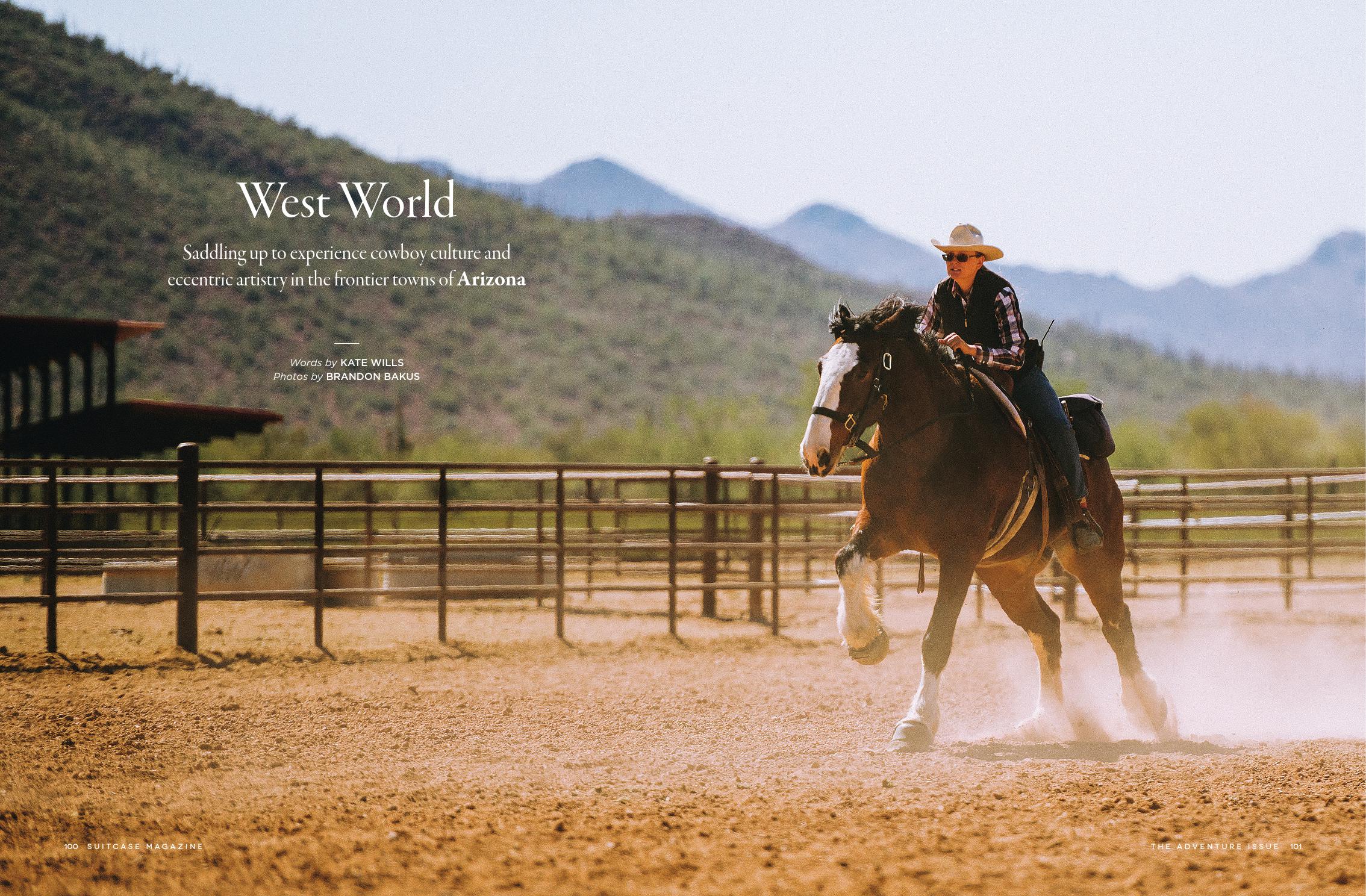
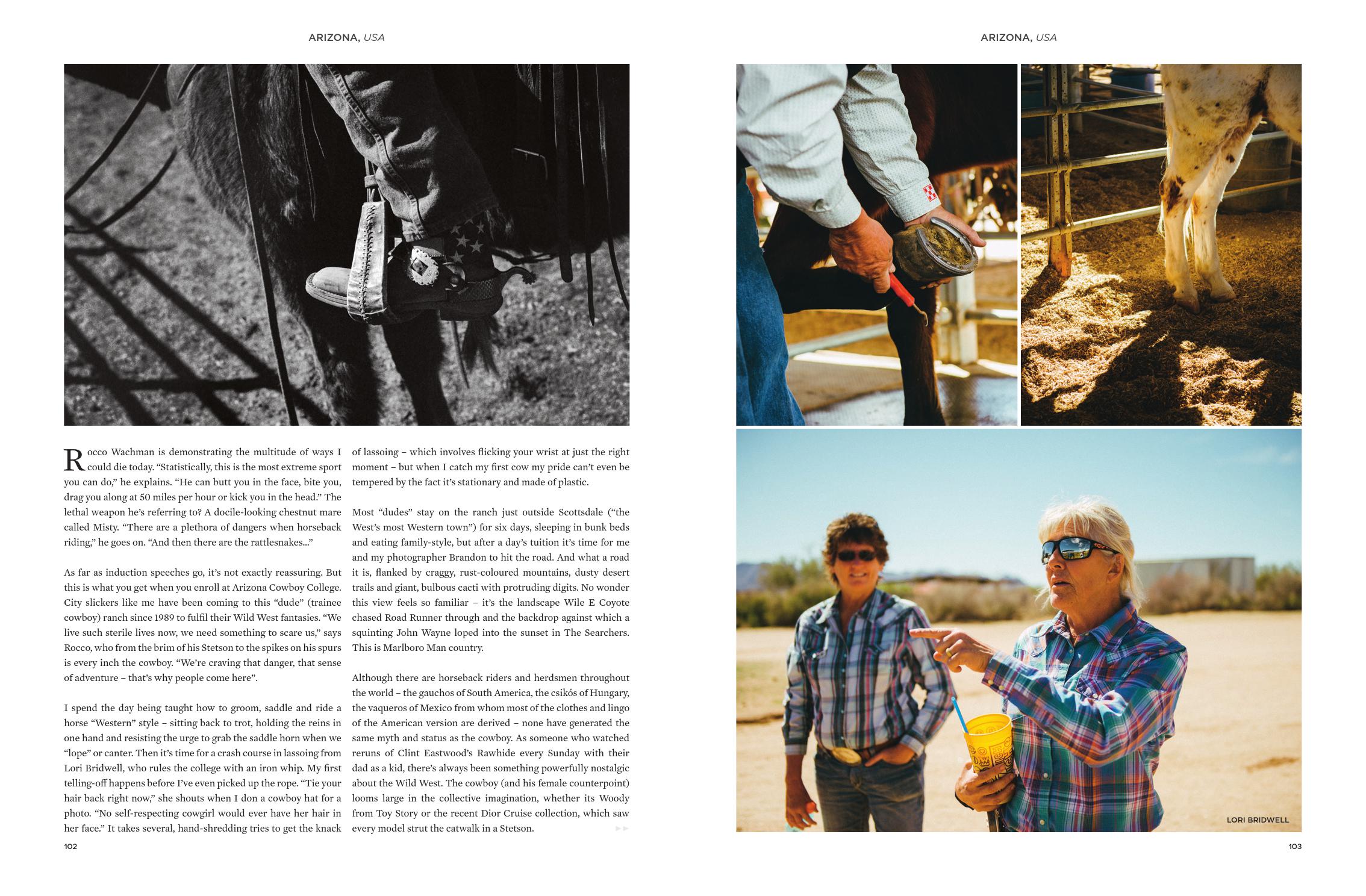

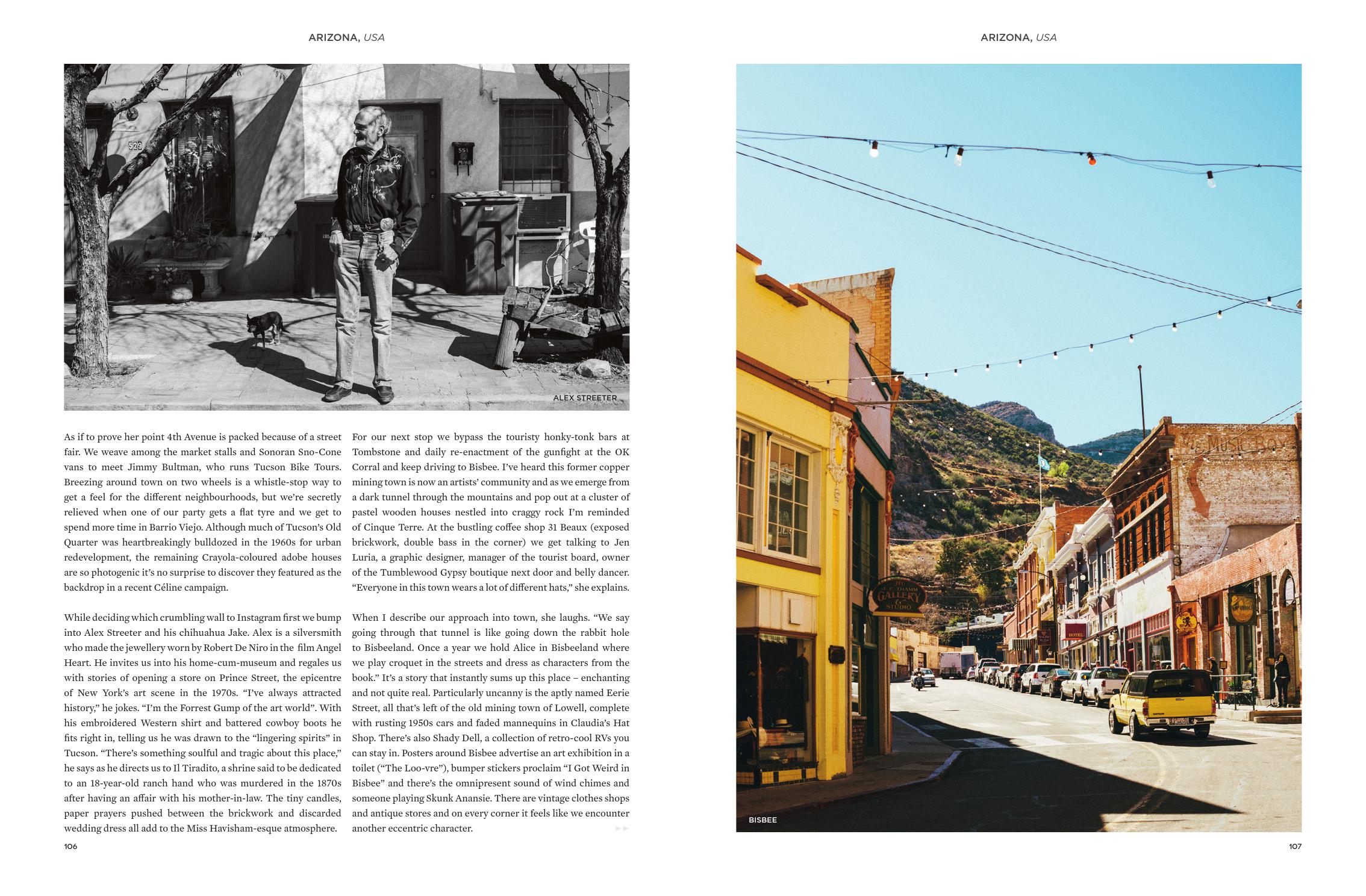
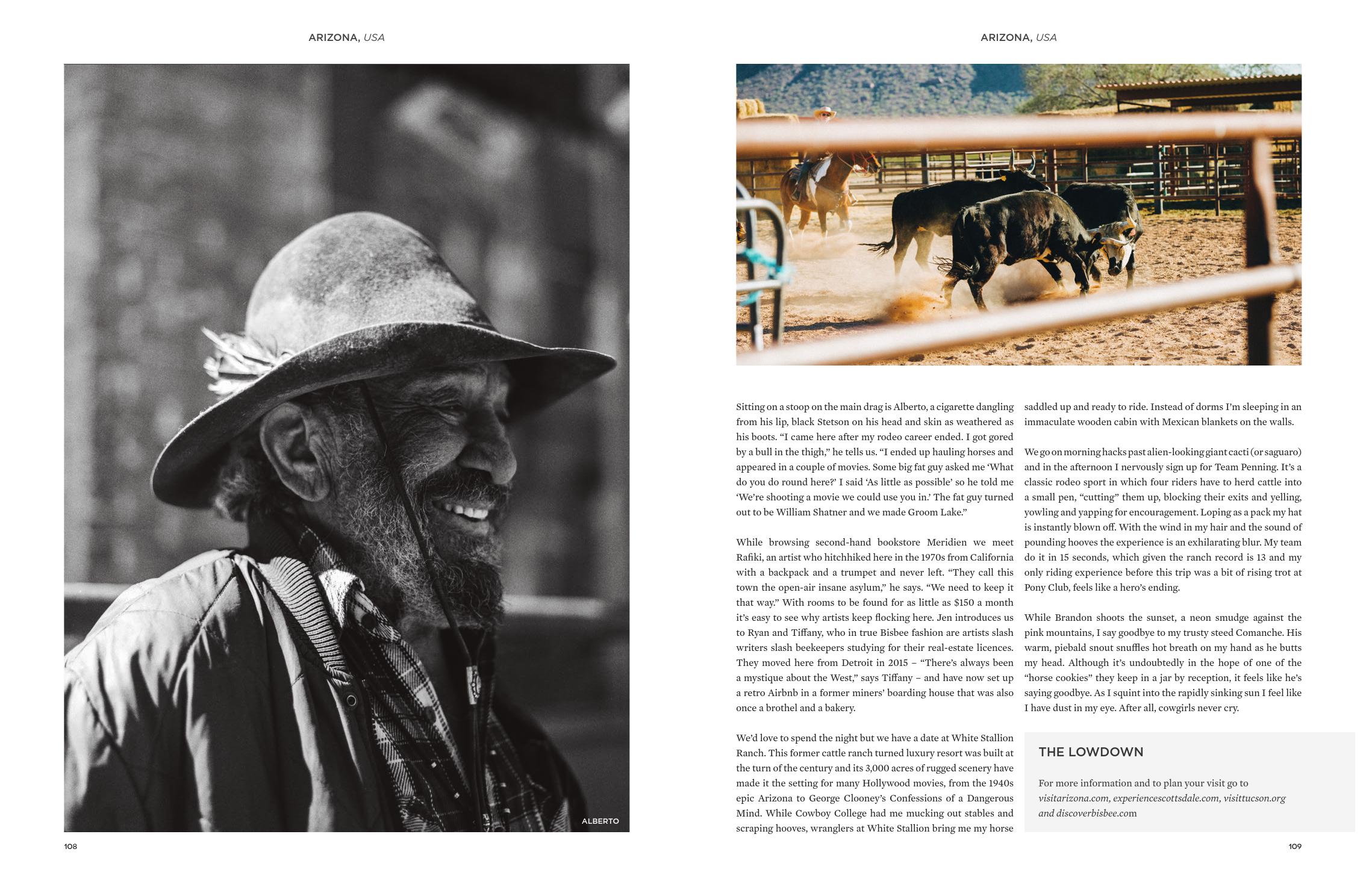
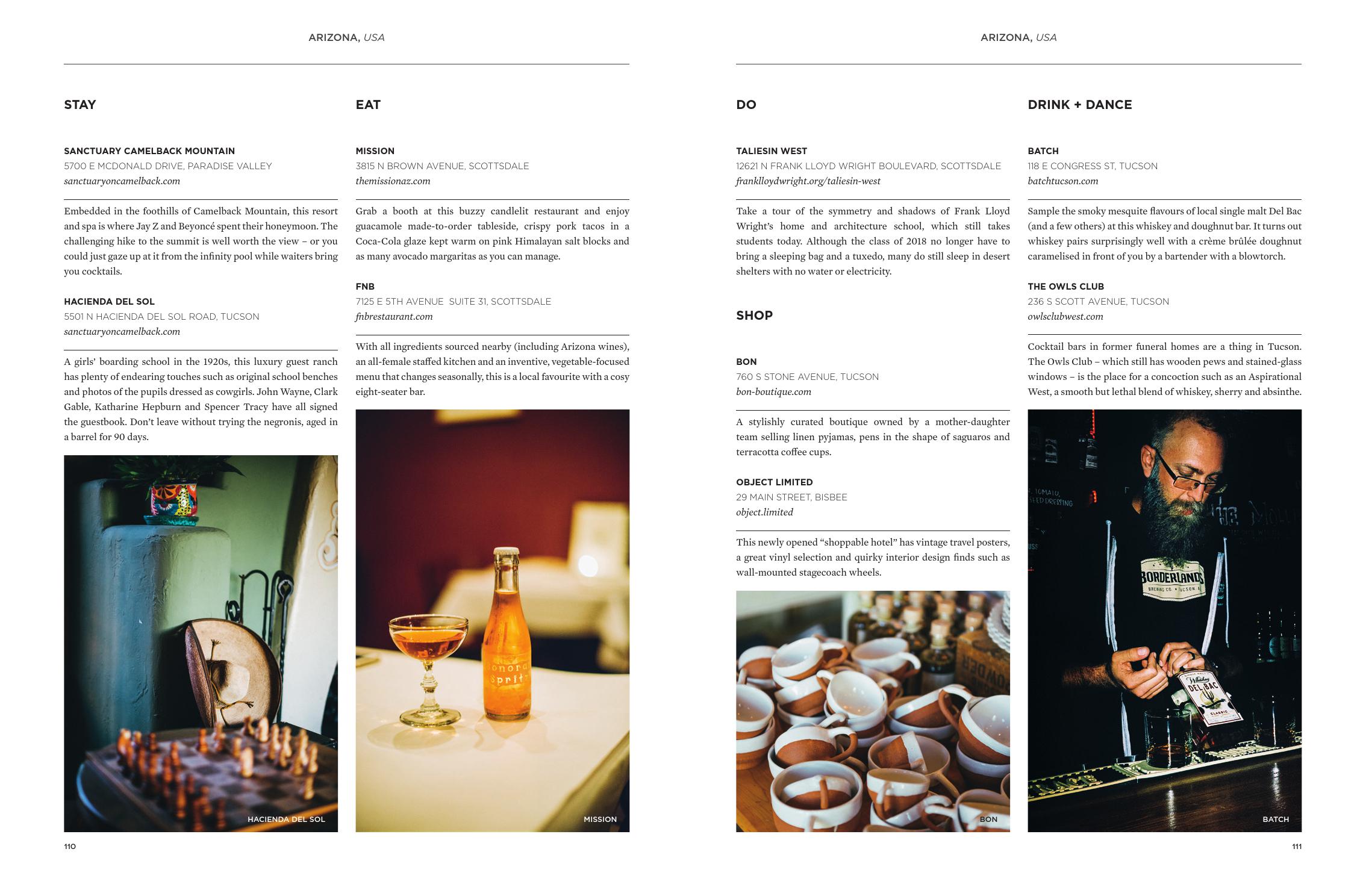
Rocco Wachman is demonstrating the multitude of ways I could die today. “Statistically speaking this is the most extreme sport you can do,” he explains. “He can butt you in the face, bite you, drag you along at 50 miles per hour, kick you in the head.” The lethal weapon he’s referring to? A docile-looking chestnut mare called Misty. “There are a plethora of dangers when horseback riding,” he goes on. “And then there are the rattlesnakes…”
As far as induction speeches go, it’s not exactly reassuring. But this is what you get when you enrol at Arizona Cowboy College. City slickers like me have been coming to this ‘dude’ ranch (‘dude’ is the name for trainee cowboys) since 1989 to fulfil their Wild West fantasies. “We live such sterile lives now, we need something to scare us,” says Rocco, who is every inch the cowboy, from the brim of his cream stetson to the spikes on his spurs. “We’re craving that danger, that sense of adventure – that’s why people come here”.
I spend the day being taught how to groom, saddle and ride a horse ‘Western’ style – sitting back to trot, holding the reins in one hand and resisting the urge to grab the saddle horn when we ‘lope’ or canter. Then it’s time for a crash course in lassoing from Lori Bridwell, who rules the college with an iron whip. My first telling off happens before I’ve even picked up the rope. “Tie your hair back right now,” she shouts when I don a cowboy hat for a photo. “No self-respecting cowgirl would ever have her hair in front of her face.” It takes several, hand-shredding tries to get the knack of lassoing – which involves flicking your wrist at just the right moment – but when I catch my first cow, my pride can’t even be tempered by the fact it’s stationary and made of plastic.
Most ‘dudes’ stay on the ranch, just outside Scottsdale (motto: ‘the West’s most Western town’) for six days – sleeping in bunk beds and eating family-style – but after a day’s intense tuition, it’s time for me and my photographer Brandon to hit the road. And what a road it is, flanked on either side by craggy rust-coloured mountains, dusty desert trails and giant, bulbous cacti with protruding digits. No wonder this view feels so familiar – it’s the landscape Wile E Coyote chased Roadrunner through, the backdrop a squinting John Wayne loped into the sunset against in <The Searchers>, where Desperate Dan strutted across my pages in <The Dandy>. This is Marlboro Man country.
Although there are horseriders and herdsmen throughout the world – the gauchos of south America, the csikos of Hungary, the vaqueros of Mexico from whom most of the clothes and lingo of the American version are derived – none have generated the same myth and status as the cowboy. As someone who watched reruns of Clint Eastwood’s <Rawhide> every Sunday with their dad as a kid, there’s always been something powerfully nostalgic about the Wild West. The cowboy (and his female counterpoint) looms large in the collective imagination, whether its Woody from <Toy Story> or the recent Dior Cruise collection, which saw every model strut the catwalk with a stetson.
The lone, silent cowboy hero, and his association with freedom, strength and self-reliance continues to fascinate, and there’s arguably no better place to understand America’s sense of itself and the construction of its national mythology than these wide-open frontier towns in Arizona. Clearly Brandon is similarly enraptured. He spends most of our drives with one hand on the wheel, the other on his Nikon shooting out the window. With his red shirt and Johnny Cash on the stereo, this has the makings of an epic road trip. If only we had a Ford Thunderbird and not a rented Nissan, we could be Thelma and Louise.
Passing squat dusky pink Baptist churches we see painted signs for ‘Pecans for Sale’, billboards with ‘Got Jesus?’ on them and adverts for Cheese Curds – deep fried curdled milk – which, according to Brandon, I don’t know what I’m missing out on. About 30 miles from Tucson it starts hailing, but when we pull up at Mission San Xavier del Bac, the clouds part and the sun illuminates the ornate Spanish colonial ‘white dove of the desert’ in a not ungodly way. Maybe those billboards are onto something. We poke around the candy-coloured cornices and feel uneasy at the glossing over of colonial history in the museum – “no doubt the Sobaipuri Indians living in the village of Wa:k were surprised to discover their land belonged to the Spanish in 1692”. A reminder of the profound violence that undergirds any myths of how the west was won.
At Welcome Diner – which, with its formica-topped bar and aquamarine stools is straight out of a John Register painting – we meet Dan Gibson, a former editor of <Tucson Weekly>. “Tucson is changing, but in many ways it hasn’t changed at all,” he tells us, over a hibiscus honey iced tea and a Big Jim, a fried buttermilk chicken sandwich on what Americans call a biscuit, but is quite clearly a scone. “Ten years ago you wouldn’t really hang out Downtown, now there are great restaurants, cocktail bars, local breweries and most of them are in historic buildings where you can still hear the train go by. Tucson still has this rustic Western feel to it.” In 2015 Unesco designated Tucson one of its Cities of Gastronomy, the first city in the US to receive the award.
One person who’s no doubt seen more changes than most around here is Tiger Ziegler. The 84-year-old bartender at the Hotel Congress has been mixing Margaritas on this spot since 1954. “I got the best job in the world,” he tells me, after he’s discreetly looked up the ingredients for an Old Fashioned in a laminated file he keeps in a cupboard. “I’m old but I don’t want to retire – I’m not going to die at home on the couch.” Wearing a long brown leather jacket, branded apron and Bolo tie, Tiger recalls how when he first started working here, the only beers were Bud and Coors for 15c a mug. The hotel itself, built in 1919 for travellers from the East passing through on the new railroad line, has a few stories of its own – it’s where notorious bank robber John Dillinger was finally captured after a fire nearly burned the place down. “I don’t serve the ghosts and they don’t bother me,” says Tiger, with a wave of his hand, when I bring up the hotel’s haunted reputation.
The next morning, feeling – appropriately enough – like death warmed up, we drag ourselves to Exo Roast Company, a speciality coffee-shop which roasts its beans on-site in a light-filled cavernous space which used to be a toy factory. Over barrio bread with barrel cactus jam and a Chiltepin Cold Brew – a combination of chocolate and chiltepin pepper from nearby Mexico – we get chatting to owner Amy Smith. When she moved from Portland, Oregon to Tucson in 2004, there were no third-wave coffee shops here and nothing else on this block. You’ll now find Gypsy Rose, an upscale vintage boutique, and Tap and Bottle, a craft beer bar. “When we opened, nobody had heard of pour-overs or could understand why you’d wait for your coffee, so people took a little convincing,” she says. “But this is how neighbourhoods get regenerated, we just had this belief that if we built it – people would start coming.”
As if to prove her point, today 4th Avenue is packed because of a street fair, and we weave among the market stalls and Sonoran Sno-Cone vans to meet Jimmy Bultman who runs Tucson Bike Tours. Breezing around town on two wheels is a whistlestop way to get a feel for the different neighbourhoods, but we’re secretly relieved when one of our party gets a flat tire and we get to spend more time in Barrio Viejo. Although much of Tucson’s Old Quarter was heartbreakingly bulldozed in the 1960s for urban redevelopment, the remaining Crayola-coloured adobe houses are so photogenic it’s no surprise to discover that they featured as the backdrop to a recent Céline campaign.
While deciding which crumbling wall to Instagram first, we bump into Alex Streeter and his chihuahua Jake. Alex is a silversmith who made the jewellery for the Robert De Niro film <Angel Heart>, and a few wrestlers and rock stars along the way. He invites us into his home-cum-museum, and regales us with stories of growing up on Haight Ashbury and opening a store on Prince Street, Soho – the epicentre of New York’s art scene in the 1970s. “I’ve always attracted history,” he jokes. “I’m the Forrest Gump of the art world”. With his embroidered Western shirt and battered cowboy boots he fits right in here and he tells us he was drawn to the “lingering spirits” in Tucson. “There’s something soulful and tragic about this place,” he says. He directs us to Il Tiradito, a shrine said to be dedicated to an 18-year-old ranch hand, murdered in the 1870s after having an affair with his mother-in-law. The tiny candles, paper prayers pushed between the brickwork and, somewhat incongruously, a discarded wedding dress, all add to the surreal atmosphere.
For our next stop we’ve decided to bypass the touristy honky tonk bars at Tombstone – and the daily re-enactment of the gunfight at OK Corral – and keep on driving to Bisbee. I’ve heard that this former copper mining town is now an artists’ community, and as we emerge from a dark tunnel through the mountains and pop out at a cluster of pastel wooden houses nestled into craggy rock, I’m instantly reminded of Cinqueterre. At the bustling coffee shop 31 Beaux (exposed brickwork, double bass in the corner) we get talking to Jen Luria, a graphic designer, manager of the tourist board, owner of Boutique Gipsy – the shop next door, and also a belly dancer. “Everyone in this town wears a lot of different hats,” she explains.
When I describe our approach into town, she laughs. “We say going through that tunnel is going down the rabbit hole to Bisbeeland. Once a year we hold ‘Alice in Bisbeeland’ where we play croquet in the streets and dress as characters from the book.” It’s a story which instantly sums up this place – enchanting and not quite real. Particularly uncanny is the aptly-named Eerie Street – all that’s left of the old mining town of Lowell – complete with rusting 1950s cars and faded mannequins in Claudia’s Hat Shop. And then there’s Shady Dell, a collection of retro-cool vintage RVs which you can stay in. Posters around Bisbee advertise an art exhibition in a toilet (“The Loo-vre”), bumper stickers say “I Got Weird In Bisbee”, there’s the sound of wind chimes and someone playing Skunk Anansie. There are vintage clothes shops, antique stores, and on every corner it feels like we encounter an eccentric character.
Sat on a stoop on the main drag is Alberto, with his cigarette dangling from his lip, black Stetson, and skin as weathered as his boots. “I came here after my rodeo career ended, I got gored by a bull in the thigh,” he says. “I was still a cowboy so I ended up hauling horses and I appeared in a couple of movies. Some big fat guy asked me ‘What do you do round here?’ and I said ‘As little as possible’, so he told me ‘We’re shooting a movie we could use you in.’ The fat guy turned out to be William Shatner and we made the movie <Groom Lake>.”
While browsing in secondhand bookstore Meridien we meet “Rafiki”, an artist who hitchhiked here in the 70s from Berkeley, California with a backpack and a trumpet and never left. “They call this town the open-air insane asylum,” he says. “We need to keep it that way.” With rooms to be found for as little as $150 a month it’s easy to see why artists keep flocking here. Jen introduces us to Ryan and Tiffany – who in true Bisbee fashion are artists slash writers slash beekeepers, oh and they’re studying for their real estate licences. They moved here from Detroit in 2015 – “there’s always been a mystique about the West,” says Tiffany – and have now set up a retro AirBnb in a former miners’ boarding house which was also once a brothel and a bakery.
We’d love to spend the night, but we have a date at White Stallion Ranch. This former cattle ranch turned luxury resort was built at the turn of the century and its 3,000 acres of rugged cinematic scenery have made it the setting for many Hollywood movies, from the 1940s epic <Arizona>, to George Clooney’s <Confessions of a Dangerous Mind>. While Cowboy College had me mucking out stables and scraping hooves, wranglers at White Stallion bring me my horse saddled up and ready to ride. Instead of dorms, I’m sleeping in an immaculate wooden cabin with Mexican blankets on the walls.
We go on morning hacks past those surreal-looking giant cacti (or saguaro as they’re called), and in the afternoon I nervously sign up for Team Penning. It’s a classic rodeo sport in which four riders have to herd cattle into a small pen, ‘cutting’ them up, blocking their exits and yelling, yowling and yapping for encouragement. Loping as a pack, my hat is instantly blown off, and with the wind in my hair and the sound of pounding hooves, the experience is an exhilarating blur. My team do it in 15 seconds, which given the ranch record is 13, and my only riding experience before this trip was a bit of rising trot at Pony Club, feels like a hero’s ending.
While Brandon shoots the sunset – a neon smudge against the pink mountains – I say goodbye to my trusty steed Comanche. His warm, piebald snout snuffles hot breath on my hand as he butts my head. Although it’s undoubtedly in the hope of one of the ‘horse cookies’ they keep in a jar by reception, it feels like he’s saying goodbye. As I squint into the rapidly-sinking sun, I feel like I have dust in my eye. After all, cowgirls never cry.
<xhead> ARIZONA
TO STAY
Sanctuary Camelback Mountain, Scottsdale
Embedded in the foothills of Camelback Mountain, this resort and spa is where Jay Z and Beyoncé spent their honeymoon. The challenging hike to the summit is well worth the views, or you could just gaze up at it from the infinity pool while waiters bring you cocktails.
Hacienda Del Sol, Tucson
A girls’ boarding school in the 1920s, this luxury guest ranch has plenty of endearing touches, such as original school benches and photos of the pupils dressed as cowgirls. John Wayne, Clark Gable, Katherine Hepburn and Spencer Tracey have all signed the guestbook. Don’t leave without trying their Negronis, aged in a barrel for 90 days.
TO EAT
Mission, Scottsdale
Grab a booth at this buzzy candlelit restaurant and enjoy guacamole made-to-order tableside, crispy pork tacos in a Coca-Cola glaze – kept-warm on pink Himalayan salt blocks – and as many avocado Margaritas as you can manage.
Fnb, Scottsdale
With all ingredients sourced nearby (including Arizona wines), all-female chefs in the kitchen and an inventive, vegetable-focused menu which changes seasonally, this is a local favourite, with a cosy 8-seater bar attached next door.
TO DO
Talesin West, Scottsdale
Take a tour of the symmetry and shadows of Frank Lloyd Wright’s home and architecture school, which still takes students today. Although the Class of 2018 no longer have to bring a sleeping bag and a tuxedo, many do still sleep in desert shelters with no water or electricity.
TO SHOP
Bon, Tucson
A stylishly-curated boutique owned by a mother-daughter team, selling linen pyjamas, pens in the shape of saguaros and terracotta coffee cups.
Object Limited, Bisbee
This newly-opened ‘shoppable hotel’ has vintage travel posters, a great vinyl selection and quirky interior design finds such as wall-mounted stagecoach wheels.
DRINK AND DANCE
Batch, Tucson
Sample the smoky Mesquite flavours of local single malt Del Bac (and a few others) at this whiskey and doughnut bar. It turns out whiskey goes surprisingly well paired with a Creme Brulee doughnut, caramelised in front of us by a bartender with a blowtorch.
Owl’s Club, Tucson
Cocktail bars in former funeral homes is a ‘thing’ in Tucson. Tough Luck Club is more of a basement dive, whereas Owl’s Club – which still has the wooden pews and stained-glass windows from its former life – is the place for a cocktail, such as an Aspirational West, a smooth but lethal blend of whiskey, sherry and absinthe.